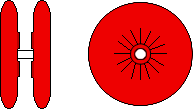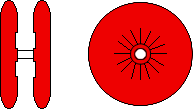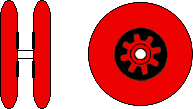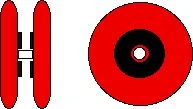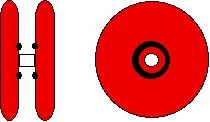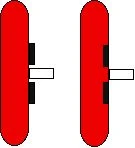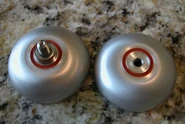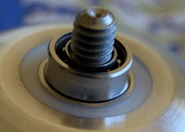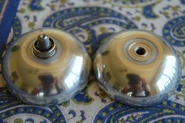The response system is what makes the yo-yo return to the player's hand or 'wake up'.
How a response system works[]
When you throw the yo-yo, the grip of the response system on the string is what transmits the force from the string to the yo-yo body to start the yo-yo spinning as it falls. A yo-yo with little response may feel like it 'slips' as it falls, due to not having enough grip on the string to make it start spinning sufficiently.
The response system also affects how the yo-yo returns. Some yo-yos return at the slightest tug on the string, some require a rather sharp tug, and some do not return at all unless you wrap the string around the axle (known as a Bind). Yo-yoers refer to yo-yos as having good, little or no response.
To understand why a response system is so important, let's first discuss what happens when the yo-yo returns. It's not so much the tug itself, but the moment that the string is slack for after the tug. During this moment, the string starts to wind around the axle two to three times until it is firmly wedged between the halves of the yo-yo. From that point on the momentum of the yo-yo is transformed to vertical movement up the string. This is why a yo-yo that is still spinning but only slowly will not return.
Types of Response Systems[]
During the first moment of slackness however there has to be some sort of friction, that causes the string to make those crucial first windings around the axle. The following section describes the different ways to achieve this:
Fixed Axles[]
In fixed axle yo-yos, this friction usually comes directly from the axle. This is enough to tightly wind up the string. Plastic yo-yos with fixed metal axles often combine this with a starburst.
Starbursts[]
A starburst is a raised, star- or asterisk-shaped figure around the axle, that slightly protrudes from the inner wall of the string gap. It is meant to provide a good grip, once the string touches it. The disadvantages of a starburst are, that they are sometimes noisy when the string touches them during play, and that they can wear out with time if the plastic used in the manufacturing of the yo-yo is too soft. The Team Losi Cherry Bomb was notorious for this. Once the starburst is gone, there is no way of replacing it. Another problem is that it is very difficult to add these to aluminum yo-yos, because you can't create them on a lathe. Popular for looping yo-yos and beginners' models, even today. The starburst was originally proposed by a Duncan employee sometime in 1950, and since then, starbursts were the be-all and end-all for the yo-yo's response system.
Reverse Starbursts[]
While a starburst protrudes into the yo-yo's gap, the reverse starburst, patented by Playmaxx, is an arrayed series of radial grooves or cuts that are recessed into the inner surfaces of the yo-yo. This made for a much milder response system that eliminated many of the disadvantages of traditional starbursts. It was also a much easier modification for the average user to implement to his own yo-yos, as a sharp cutting tool was all he/she needed to add radially spaced cuts or grooves into the inner surfaces of both plastic and metal yo-yos. The original Henrys Viper was a common recipient of just such a modification.
Brake Pads[]
Playmaxx refined the reverse starburst concept by adding rubber pads with arrayed "teeth" that form a starburst pattern around the bearing. This Brake Pad Technology (BPT) was also patented by Playmaxx, and was one of the first modern systems that used replaceable pads/stickers. The rubber pads (resembling cork in appearance) with adhesive backing are set into the yo-yo halves, and provide an additional level of friction to catch the string thus providing responsiveness. The Brake Pads eventually lose their response over time and need replacement, and the rough surface of worn pads prevents the yo-yo from being quite as smooth on the string as some other response systems. This became the basis of all modern response pad systems.
Brake Pads are still used in the Duncan DragonFly and Bumblebee yo-yos, and especially the new Ignite looping yo-yo.
Friction Stickers/Response Pads[]
Though patented in Great Britain in 1984, friction stickers (also referred to as response pads) did not gain real popularity until the late 1990s when the production of aluminum yo-yos increased greatly. Unlike reverse starbursts, which are permanent, and Brake Pads, which require a yo-yo designed to use them, these thin circular sheets of rubber or cloth can be applied to the inner surfaces of almost any yo-yo to increase responsiveness and then, if desired, removed. Major advantages of these is that they can be replaced when worn out, or exchanged for a different kind of material, if you do not like the feel of the particular kind your yo-yo came with. One can even mix different kinds on one yo-yo.
They can be either mounted on the inner wall or recessed into it.
O-Rings[]
O-rings are rubber rings that sit in a groove around the axle. They function the same as friction stickers, but they last longer. They are a staple in YoYoJam yo-yos.
Silicone[]
Silicone has gained widespread popularity during the last several years as a material for response systems. It is available as flowable liquid silicone or as ready-made response pads and/or O-rings. While the stickers or rings just replace their rubber counterparts, flowable liquid silicone is usually injected in the recess and left to dry. Afterwards, any excess is shaved off using a sharp knife. Yo-yos with recessed silicone response systems are generally considered to be for advanced and even professional-level players who enjoy very little response, and use a bind to return the yo-yo.
Hybrid Response Systems[]
The term hybrid is used for a response system that mixes any of these systems, most notably the mix of one O-ring and one starburst made popular by YoYoJam.
Methods of modifying response systems[]
Recessing[]
One problem with most response systems is that they protrude from the inner wall (left image) of the yo-yo and thus sometimes rub against the string, slowing the yo-yo down. To get around this, some manufacturers have started to make little cavities into the yo-yo gap, so a response sticker can be mounted flush with the rest of the wall (right image).
For existing yo-yos, it is also a very popular modification (or "mod") to add this little recess using a lathe. There are even professional yo-yo modders that sell recessed versions, like Takeshi Kamisato's recessed Freehand Zero.
Homemade Response Pads[]
Dropped in popularity since around 2005, people used to take Brake Pads and cut them out, thus creating homemade friction stickers. People have since stopped using them as silicone response has become more widely used.
Shaved O-Rings[]
This is a mod to achieve a recessed response system on an O-ring response yo-yo. It is done by simply shaving the protruding part of the rings off until they are flush (or nearly flush) with the inner walls of the yo-yo.
Adding thick lubrication[]
Transaxle yo-yos often have very little response. One of the first solutions to solve this was to slow them down by applying a thick lubricant (thick lube) to the bearing. This (usually combined with another response system) makes for just enough resistance to make the string wind up until it grips and wedges itself into the yo-yo sides. The downside of this, is that the yo-yo does not spin as long due a faster rate of deceleration of the yo-yo spin speed.
One very interesting yo-yo in this regard is the Came-Yo Mondial, which has a special hole in the axle hub through which the user can pump thick lube using a syringe without having to unscrew the halves.
